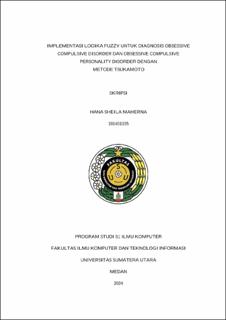Implementasi Logika Fuzzy untuk Diagnosis Obsessive Compulsive Disorder dan Obsessive Compulsive Personality Disorder dengan Metode Tsukamoto
Implementation of Fuzzy Logic for The Diagnosis of Obsessive Compulsive Disorder and Obsessive Compulsive Personality Disorder Using The Tsukamoto Method

Date
2024Author
Maherna, Hana Sheila
Advisor(s)
Ginting, Dewi Sartika Br
Jaya, Ivan
Metadata
Show full item recordAbstract
Obsessive-Compulsive Disorder (OCD) is a mental disorder characterized by the presence of obsessions (uncontrollable thoughts) and compulsions (repetitive actions performed to reduce the anxiety caused by these obsessions). In contrast, Obsessive-Compulsive Personality Disorder (OCPD) is a personality disorder marked by a pattern of perfectionistic thinking and behavior, along with strict control over oneself and others. The lack of public understanding regarding the differences between OCD and OCPD contributes to the increasing stigma associated with mental health. Therefore, it is imperative to address mental health issues such as OCD and OCPD seriously in order to enhance overall well-being. This study seeks to implement fuzzy logic in diagnosing OCD and OCPD through the Tsukamoto Method. Conducted in Langkat Regency, the research involves gathering data from 40 respondents and validation and testing by a qualified psychiatrist. The expert system focuses on identifying OCD and OCPD based on 20 symptoms. The findings of this research will demonstrate the distinctions between OCD and OCPD, as indicated by user-inputted symptoms, as well as the probability of having either condition. By employing fuzzy logic in the expert system, the diagnosis accuracy for OCD and OCPD reaches 90%. It can be inferred that the system has exhibited commendable performance in validating the diagnosis of OCD or OCPD.
Collections
- Undergraduate Theses [1254]
